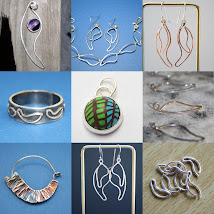

The idea for this necklace had its origins earlier this year. At my jewellery making evening class we were given the opportunity to have an object cast in silver. The object had to be one that would be burned away in the
lost wax casting method, and I took along a cluster of three empty acorn cups.

The resulting silver piece was attractive, and I toyed with the idea of adding felt balls to the cups, but in the end decided the silver was just a little heavy for jewellery.

When autumn arrived I started to make a selection of felt balls in autumnal colours, some with patterns. I wanted to make something a little different from the plain bead strings I'd made before, and it was when I picked up some more acorn cups that I realised what to do. I would put felt balls into real acorn cups. These would require cold connections, so this would also give me more practice with tube riveting, with which I haven't had much success to date. The main part of the necklace (there's a photo right at the end of this post) is made up of felt balls strung on 0.46 mm 7 strand beading wire. The balls are made from merino tops. The basic shape of each one was made by needle felting. A few of the balls have patterns (spots and stripes) that were added by needle felting. All the balls were finished off by wet felting. The necklace has a wet-felted string, and fastens with a felted ball and loop. There are silver jumps rings included in various places to balance the appearance of the shiny rivets.

It is the pendant that involved the most work. It is made up of two acorn cups, complete with stalks, and bound together with 0.6 mm sterling silver wire. Each cup has a felt ball attached to it by a tube rivet. Here's how I did the riveting.
Step 1. Wash the acorn cups thoroughly. I collected mine in an area grazed by sheep so was very conscious of the need for this!
 Step 2.
Step 2. Make the first hole in the side of the cup. I used a 1.2 mm bit in a small hand drill, and then enlarged the hole with a 1.5 mm drill (I am going to be using 1.6 mm outer diameter tubing for the riveting). I found that trying to bevel the outside of the hole to get a countersunk rivet led to me breaking the acorn cups. This is an option better left for riveting in metal.
Step 3. Start the second hole by first putting the drill through the first hole, so that the two holes will be well aligned. Make the second hole.
 Step 4.
Step 4. Before cutting the tubing, push it through both holes. This will enlarge the hole to just the right size and you can mark the tube to show where to cut. Have only about 1 mm sticking out at each end. If the tube is too long it will bend when you try to form the rivet - I know, mine did!
Step 5. Cut the tube to length using a piercing saw, neaten the ends with a needle file.
 Step 6.
Step 6. Place a felt ball in the cup. Run a large needle through the holes and through the ball. Repeat in the other direction. Then place the needle back in the channel you have just created and pull the needle back and forth, keeping it in the ball, so that you can remove the cup.
 Step 7.
Step 7. Replace the needle with a round needle file or an awl and leave it in place. This will enlarge the channel ready to take the tubing, but it needs to stay in place as holes in felt balls are self healing, and the hole will have disappeared by the time you've picked up your tubing for the next step!
 Step 8.
Step 8. Push the cut-to-length tube through the hole in the ball instead of the file/awl.
 Step 9.
Step 9. Insert the ball and tube into the cup, pushing the ends of the tube through the holes in the cup.
 Step 10.
Step 10. Fix the tube in place using standard tube riveting techniques, which I won't cover here. Tube riveting is described in most Jewellery Techniques books, and there's an online tutorial available
here. You need to register to get access to the tutorial, but registration is free.
 Step 11.
Step 11. Throw away your broken acorn cup, choose a new one and return to step 2! It was difficult to rivet the delicate acorn cups, and I broke five cups along the way to successfully riveting two for the pendant.
And here's the finished necklace:

It has both fibre and found objects and fits the
Whiplash theme for October/November 2007, which is fibre & mixed media inspired jewellery.



































